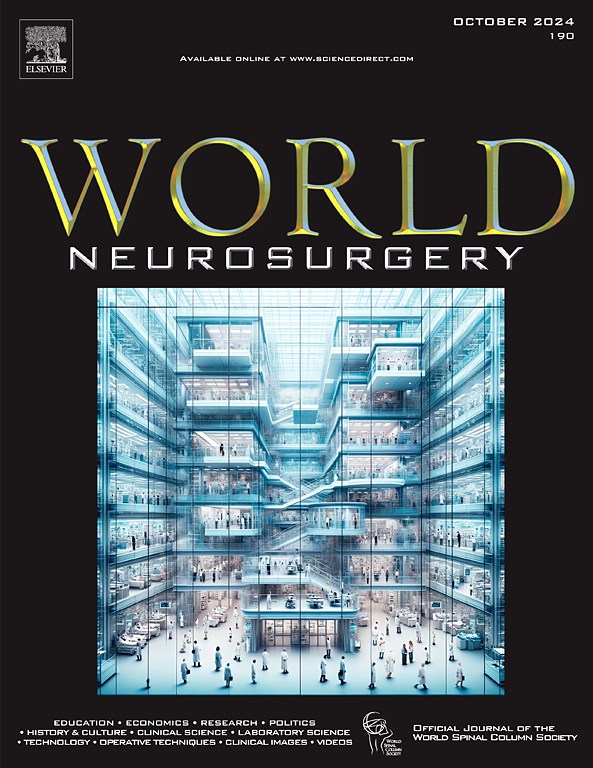侧位腰椎椎体间融合术(LLIF):经腰肌手术与肌肉大小改变和临床表现有关吗?
IF 2.1
4区 医学
Q3 CLINICAL NEUROLOGY
引用次数: 0
摘要
侧位腰椎椎体间融合术(LLIF)是基于通过腹膜后和腰肌的低侵入性通道,尽管对术后虚弱和手术侧神经病变的担忧仍然存在。本研究探讨了经腰肌LLIF入路是否与腰肌形态、髋屈肌无力和下肢感觉不良的长期变化有关。方法:作者回顾性分析了2016年1月至2024年6月在同一机构的所有LLIF病例。纳入需要术前和术后磁共振成像的可用性。腰大肌横截面积在L4上终板和手术水平处测量。临床结果通过标准化牛津运动检查、标准化感觉检查和由主治医生记录和审查的患者报告症状进行分析。结果:865例患者行LLIF,其中108例符合影像学和适应证纳入标准(男48例,女60例)。纳入患者的平均随访时间为2.8年(3.8个月- 7.3年)。我们观察到手术侧腰肌大小平均减少了6.3%,具有统计学意义(结论:我们的研究发现,LLIF与手术侧腰肌大小和质量的长期轻微下降、平均双侧力量损失小、无侧特异性感觉缺陷有关。本文章由计算机程序翻译,如有差异,请以英文原文为准。
Lateral Lumbar Interbody Fusion (LLIF): Is Trans-Psoas Surgery Associated with Muscle Size Changes and Clinical Findings?
Objective
Lateral lumbar interbody fusion (LLIF) is based on a less-invasive access corridor through the retroperitoneum and psoas muscle, though concerns persist over postoperative weakness and neuropathy on the surgical side. This study investigates if the trans-psoas LLIF approach is associated with long-term changes in psoas morphology, hip flexor weakness, and lower extremity dysesthesia.
Methods
The authors retrospectively reviewed all LLIF cases at a single institution from January 2016 to June 2024. Inclusion required the availability of preoperative and postoperative magnetic resonance imaging. Psoas cross-sectional area was measured at the L4 upper endplate and the level of surgery. Clinical outcomes were analyzed through standardized Oxford motor examinations, standardized sensory examinations, and patient-reported symptoms as documented and reviewed by the attending surgeon.
Results
Eight hundred sixty-five patients underwent LLIF, of which 108 patients met inclusion criteria for imaging and indication (48 male, 60 female). The mean follow-up for included patients was 2.8 years (range 3.8 months–7.3 years). We observed a statistically significant mean decrease of 6.3% in psoas size on the surgical side (P < 0.001, Cohen's d = 0.19) and no significant change on the non-surgical side (P = 0.20, d = 0.07), both reflecting inconsequential effect sizes. Average hip flexor strength decreased by ≥ 1 grade in 8 (14.5%) patients on the surgical side and 5 patients (9.1%) on the nonsurgical side, with no significant difference between groups (P = 0.85).
Conclusions
Our study found that LLIF was associated with minor long-term decreases in psoas size and quality on the surgical side, small mean bilateral strength losses, and no side-specific sensory deficits.
求助全文
通过发布文献求助,成功后即可免费获取论文全文。
去求助
来源期刊

World neurosurgery
CLINICAL NEUROLOGY-SURGERY
CiteScore
3.90
自引率
15.00%
发文量
1765
审稿时长
47 days
期刊介绍:
World Neurosurgery has an open access mirror journal World Neurosurgery: X, sharing the same aims and scope, editorial team, submission system and rigorous peer review.
The journal''s mission is to:
-To provide a first-class international forum and a 2-way conduit for dialogue that is relevant to neurosurgeons and providers who care for neurosurgery patients. The categories of the exchanged information include clinical and basic science, as well as global information that provide social, political, educational, economic, cultural or societal insights and knowledge that are of significance and relevance to worldwide neurosurgery patient care.
-To act as a primary intellectual catalyst for the stimulation of creativity, the creation of new knowledge, and the enhancement of quality neurosurgical care worldwide.
-To provide a forum for communication that enriches the lives of all neurosurgeons and their colleagues; and, in so doing, enriches the lives of their patients.
Topics to be addressed in World Neurosurgery include: EDUCATION, ECONOMICS, RESEARCH, POLITICS, HISTORY, CULTURE, CLINICAL SCIENCE, LABORATORY SCIENCE, TECHNOLOGY, OPERATIVE TECHNIQUES, CLINICAL IMAGES, VIDEOS
 求助内容:
求助内容: 应助结果提醒方式:
应助结果提醒方式:


